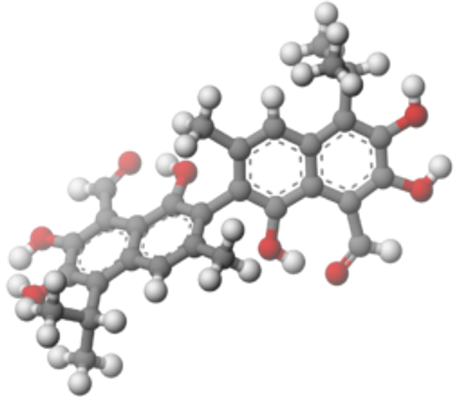COMPLEXES OF WATER-SOLUBLE LOCAL PLANT POLYPHENOL DERIVATIVES AND THEIR BIOLOGICAL ACTIVITY
UDC 547.562.1.+615:
Abstract
The article is devoted to obtaining water-soluble complexes of iminoazo derivatives of gossypol, studying their physicochemical properties and biological activity. Aromatic, heterocyclic amines and sulfanilamide preparations were used as amine components in obtaining iminoazo derivatives of gossypol and their water-soluble complexes. The maximum values of wavelengths and the corresponding optical densities were determined in the UV spectra of compounds in acetone solvent. In order to determine the structure of the compounds, the infrared spectrum was taken and analyzed: the shift of the fundamental vibrational frequencies up to 31 cm-1 showed that the water-poly-N-vinylpyrrolidone in the compound is connected to a lesser extent as a result of hydrogen bonding. Obtaining complexes of azoderivatives of gossypol imines with poly-N-vinylpyrrolidone is related to the multi-functionality of the reactive groups of the ligand compound; formed hydrogen bonds due to the oxygen of the cycloamide group. For the first time, six new water-soluble complexes iminoazo derivatives of gossypol with poly-N-vinylpyrrolidone were obtained. The results of determination of interferon-inducing activity of compounds were analyzed. The activity was compared with the effectiveness of azo-, iminoazo derivatives of gossypol. According to the obtained results, it was shown that the effectiveness of water-soluble complexes iminoazo derivatives of gossypol.
Downloads
Metrics
References
Balakrishnan K., Wierda W.G., Keating M.J., Gandhi V. Blood, 2008, vol. 112, no. 5, pр. 1971–1980.
Johnson P.W.M. Annals of Oncology, 2008, vol. 19, no. 4, pр. 56–59.
Wang X., Wang J., Wong S.C.H. et al. Life Sciences, 2000, vol. 67, no. 22, pр. 2663–2671.
Ping C., Li Z., Jing-Wen L. et al. Biomedical Research, 2016, vol. 27, no. 2, pр. 419–423.
Van Poznak C., Seidman A.D., Reidenberg M.M. et al. Breast Cancer Research and Treatment, 2001, vol. 66, no. 2, pр. 239–248.
Ye W., Chang H.L., Wang L.S. et al. Anticancer Research, 2007, vol. 27, no. 1, pр. 107–116.
Jiang J., Slivova V., Jedinak A., Sliva D. Clinical and Experimental Metastasis, 2012, vol. 29, no. 2, pр. 165–178.
Badawy S.Z.A., Souid A.K., Cuenca V. et al. Asian Journal of Andrology, 2007, vol. 9, no. 3, pр. 388–393.
Ko C.H., Shen S.C., Yang L.Y. et al. International Journal of Cancer, 2007, vol. 121, no. 8, pр. 1670–1679.
Chien C.C., Ko C.H., Shen S.C. et al. Journal of Cellular Physiology, 2012, vol. 227, no. 8, pр. 3128–3137.
Hsiao W.T., Tsai M.D., Jow G.M. et al. Molecular Vision, 2012, vol. 18, pр. 2033–2042.
Wong F.Y., Liem N., Xie C. et al. PLoS ONE, 2012, vol. 7, no. 12, pр. 1–10.
Il'kevich N.S., Rybachenko V.I., Shreder G. i dr. Naukovi pratsi donetsʹkoho natsionalʹnoho tekhnichnoho universytetu. Seriya: “Khimiya I khimichna tekhnolohiya”, 2009, no. 13, pp. 110–117. (in Russ.).
Baram N.I., Ismailov A.I. Chemistry of Natural Compounds, 1993, vol. 29, p. 275. DOI: 10.1007/BF00630521.
Baram N.I., Ismailov A.I., Ziyaev Kh.L., Rezhepov K.Zh. Chemistry of Natural Compounds, 2004, vol. 40, p. 3. DOI: 10.1023/B:CONC.0000039123.09208.79.
Rezhepov K.Zh., Ziyaev Kh.L., Baram N.I., Ismailov A.I., Kamaev F.G., Saiitkulov A.M. Chemistry of Natural Compounds, 2002, vol. 38, p. 4. DOI: 10.1023/A:1021613705698
Rezhepov K.Zh., Ziyaev Kh.L., Baram N.I., Kamaev F.G., Levkovich M.G., Saiitkulov A.M., Ismailov A.I. Chemistry of Natural Compounds, 2003, vol. 39, p. 4. DOI: 10.1023/B:CONC.0000003416.49975.25
Rezhepov K.Zh., Ziyaev Kh.L., Alimbayeva Sh.B. Khimiya rastitel'nogo syr'ya, 2022, pp. 277–282. DOI: 10.14258/jcprm.20220410648
Rezhepov K.Zh., Alimbayeva Sh.B. Khimiya rastitel'nogo syr'ya, 2023, pp. 135–143. DOI: 10.14258/jcprm.20230110881
Plate N.A. Fiziologicheski aktivnyye polimery. [Physiologically active polymers]. Moscow, 1986, 296 p. (in Russ.).
Pan H. Multifunctional Pharmaceutical Nanocarriers. Springer: NY, 2008, vol. 4, pр. 81–142.
Liu S. Macromolecules, 2009, vol. 42, no. 1, pp. 3–13.
Duncan R. Nat. Rev. Cancer., 2006, vol. 6, no. 9, pp. 688–701.
Dhal P.K. Adv. Drug Deliver Rev., 2009, vol. 61, no. 13, pp. 1121–1130.
Chadha R. J. Sci. Ind. Res., 2008, vol. 67, no. 3, pp. 185–197.
Vilar G. Curr. Drug Deliver., 2012, vol. 9, no. 4, pp. 367–394.
Markovsky E. J. Controlled Release, 2012, vol. 161, no. 2, pp. 446–460.
Kopeček J. J. Controlled Release, 2001, vol. 74, no. 1-3, pp. 147–158.
Jatzkewits H. Z. Naturforsch., 1955, vol. 10b, pp. 27–31.
Ushakov S.N. Dokl. AN SSSR, 1962, vol. 147, no. 5, pp. 1102–1107. (in Russ.).
Givental' N.I., Ushakov S.N., Panarin Ye.F., Popova G.O. Antibiotiki, 1965, vol. 10, no. 8, pp. 701–706. (in Russ.).
Panarin Ye.F. Shumikhina K.I. Khimiko-farmatsevticheskiy zhurnal, 1974, no. 9, pp. 16–18. (in Russ.).

Copyright (c) 2024 chemistry of plant raw material

This work is licensed under a Creative Commons Attribution 4.0 International License.

This work is licensed under a Creative Commons Attribution 4.0 International License.
The authors, which are published in this journal, agree to the following conditions:
1. Authors retain the copyright to the work and transfer to the journal the right of the first publication along with the work, at the same time licensing it under the terms of the Creative Commons Attribution License, which allows others to distribute this work with the obligatory indication of the authorship of this work and a link to the original publication in this journal .
2. The authors retain the right to enter into separate, additional contractual agreements for the non-exclusive distribution of the version of the work published by this journal (for example, to place it in the university depository or to publish it in a book), with reference to the original publication in this journal.
3. Authors are allowed to post their work on the Internet (for example, in a university repository or on their personal website) before and during the review process of this journal, as this may lead to a productive discussion, as well as more links to this published work.











